Appendix A
Summary of the Animal Welfare Act Regulations Pertaining to Transportation
This summary of Animal Welfare Act (AWA) standards is divided into three sections. The first and second cover regulations that pertain to the transportation of dogs and cats and of nonhuman primates, respectively. The third section covers AWA regulations that pertain to the transportation of guinea pigs, hamsters, rabbits, and animals defined as other animals by the US Department of Agriculture. Other animals would include any species of warm-blooded animal other than dog, cat, guinea pig, hamster, rabbit, nonhuman primate, marine mammal, or bird. AWA regulations pertaining to marine mammals are not included in this summary but can be found in 9 CFR 3.112-3.118. This summary is not meant to be exhaustive. For example, specific directions on water temperatures and detergents that should be used to sanitize transportation enclosures are not included. However, each section refers to the original AWA regulation if further specifics are required.
DOGS AND CATS (9 CFR 3.13 – 3.19)
Enclosure
-
The primary enclosure must be strong enough to contain the animals securely and comfortably and to withstand the normal rigors of transportation.
-
Enclosures must be large enough that each animal has enough space to turn around normally while standing, to sit and stand, and to lie in a natural position.
-
Interior has no sharp points, edges, or protrusions that could injure an animal.
-
Each animal is securely contained in the enclosure and cannot put any part of its body outside the enclosure in a way that could result in injury to itself, handlers, or other persons or animals.
-
The openings of the enclosure are easily accessible at all times for emergency removal of the animals.
-
Unless the enclosure is permanently affixed to the conveyance, adequate handles or handholds should be present so that it can be lifted without tilting and ensure that anyone handling the enclosure will not come into physical contact with an animal that is inside.
-
Unless the enclosure is permanently affixed to the conveyance, labeling on the top and at least one side with the words “Live Animals” in letters at least 1 in. high and arrows indicating the correct upright position of the enclosure must be present.
-
Any material or treatment in or on the enclosure must be nontoxic.
-
A solid, leakproof bottom or removable leakproof tray under a slatted or mesh floor that prevents seepage of waste products from the enclosure is required. The slatted or mesh floor must be constructed so an animal cannot put any part of its body through the raised floor. Unless it is on a raised floor, the enclosure must contain enough unused, nontoxic litter to absorb and cover excreta.
-
Food and water receptacles must be attached inside the enclosure and placed so that they can be filled from outside the enclosure without opening the door.
-
The primary enclosure must be cleaned and sanitized before each use. If an animal is in transit for more than 24 hr, the enclosure must be cleaned and litter replaced or the animal moved to another clean and sanitized enclosure. If moving an animal from the enclosure is necessary, this procedure must be completed in a way that safeguards the animal from injury and prevents escape.
-
Projecting rims must be on the exterior of walls that contain ventilation openings and provide a minimal air circulation space of 0.75 in.
-
The size and arrangement of ventilations openings must comply with one of the following options:
Option A: Two ventilation openings
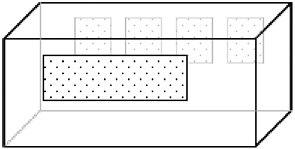
Surface area of each opening is at least 16% of wall surface area.
Total surface area of openings is at least 14% of total surface area of all walls.
One-third of surface area of openings must be in upper half of enclosure.
Option B: Three ventilation openings
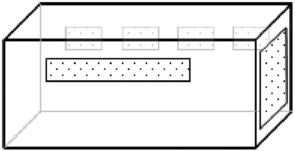
Total surface area of openings on opposing walls is at least 8% of those walls’ total surface area.
Surface area of openings on third wall is at least 50% of surface area of that wall.
Total surface area of openings is at least 14% of total surface area of all walls.
One-third of surface area of openings must be in upper half of enclosure.
Option C: Four ventilation openings
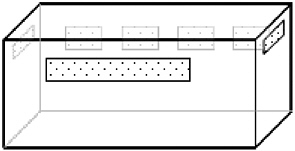
Surface area of each opening is at least 8% of surface area of that wall.
Total surface area of openings is at least 14% of total surface area of all walls.
One-third of surface area of the openings must be in upper half of enclosure.
-
If the enclosure is permanently affixed to the conveyance so that there is only a front ventilation opening, the opening cannot be blocked, must open directly to an unobstructed aisle, must be at least 90% of the total surface area of the front wall, and must be covered with bars, wire mesh, or smooth expanded metal that has air spaces.
Compatibility
-
Dogs or cats transported in the same enclosure must be of a single species and be maintained in compatible groups.
-
Puppies or kittens 4 months old or younger cannot be transported in an enclosure with adult animals other than their dams.
-
Animals that are overaggressive or exhibit a vicious disposition must be transported individually.
-
A female in estrus may not be transported in an enclosure with a male animal.
-
When transportation is by air,
-
No more than one animal 6 months old or older or weighing over 20 lb may be transported in the same enclosure.
-
No more than two puppies or kittens 8 weeks to 6 months old, of comparable size, and weighing 20 lb or less each may be transported in the same enclosure.
-
Weaned animals less than 8 weeks old must be of comparable size or must be littermates and be accompanied by their dam.
-
-
When transportation is on the ground or by privately owned aircraft,
-
No more than 4 animals 8 weeks old or older and of comparable size may be transported in the same enclosure.
-
Weaned animals less than 8 weeks old and of comparable size or animals less than 8 weeks old that are littermates and are accompanied by their dam may be transported in the same enclosure.
-
Food and Water
-
Each animal 16 weeks old or older must be offered food at least once every 24 hr.
-
Animals less than 16 weeks old must be offered food at least once every 12 hr.
-
Each animal must be offered water at least once every 12 hr.
-
Those periods start when an animal was last offered food and water before transportation began.
-
Each animal must be offered food and water within 4 hr before being transported or within 4 hr before delivery to a carrier or intermediate handler.
-
It is not acceptable to withhold food or water unless withholding is directed by a veterinarian.
Documentation
-
Certifications must be securely attached to the outside of the primary enclosure in a manner that makes them easily noticed and read.
-
For surface transportation only, the operator of the conveyance may hold documents. Certification must include
-
Consignor’s name, address, and dated signature.
-
Consignee’s name, address, and telephone number.
-
Each animal’s tattoo or tag number.
-
Time and date when each animal was last fed and watered (not to occur more than 4 hr before delivery to carrier or intermediate handler).
-
Instructions for satisfying in-transit food and water requirements for a 24-hr period, administration of drugs or medication, or other special care.
-
-
Certification of acclimation (required only if temperature of animal holding area is less than 45°F) must include
-
Consignor’s name and address.
-
Each animal’s tattoo or tag number.
-
Signed statement from veterinarian, dated no more than 10 days before delivery, that each animal is acclimated to temperatures
-
Delivery to Carriers and Handlers
-
Carriers and handlers cannot accept an animal for transportation more than 4 hr before departure time; this can be extended by 2 hr by agreement of the carrier and consignor.
-
Carriers and handlers cannot accept an animal for transportation unless the enclosure meets the requirements described above, the enclosure is free of obvious defects, the appropriate written certifications listed above are attached to the enclosure, and the carriers’ holding area meets the minimal temperature requirements described below under “Terminal Facilities” unless the animal is accompanied by a certificate of acclimation (see “Documentation” above).
Terminal Facilities
-
Shipments of animals cannot be comingled with inanimate cargo in animal holding areas of terminal facilities.
-
All holding areas must be cleaned and sanitized as often as necessary to prevent an accumulation of debris and to minimize disease hazards; an effective program must be implemented for the control of insects, ectoparasites and birds and mammals considered pests.
-
Ventilation must be provided to minimize drafts, odors, and moisture condensation; auxiliary ventilation must be used when the ambient temperature is 85°F or higher.
-
Temperature must not be below 45°F or above 85°F for more than 4 consecutive hours; temperature must be measured at a point not more than 3 ft away from the outside of the enclosure and halfway up the side of the enclosure.
-
The facility must provide shelter from sunlight, extreme heat, rain, and snow.
-
Upon arrival at a facility, if a consignee cannot be notified with 24 hr of arrival, the handler must return the animal to the consignor; if the consignee is notified but does not accept delivery within 48 hr of arrival, the handler must return the animal to the consignor.
Handling
-
When an animal is moved to or from a facility or conveyance, it must be sheltered from sunlight, extreme heat, rain, and snow.
-
The animal cannot be exposed to temperature above 85°F for more than 45 min.
-
Transporting devices must be covered when the temperature falls below 50°F; the animal cannot be exposed to temperatures below 45°F for more than 45 min unless it is accompanied by a certificate of acclimation; temperature is measured from a point not more than 3 ft from the outside of the enclosure and halfway up the side of the enclosure.
-
Handlers must avoid causing physical harm or distress to the animal.
-
The enclosure cannot be placed on an unattended conveyor belt or on an elevated conveyor belt or tossed, dropped, needlessly tilted, or stacked in a manner that results in its falling.
-
The enclosure must be handled in a manner consistent with written instructions attached to it.
Primary Conveyance
-
The cargo space of conveyances to transport animals must be designed, constructed, and maintained in a manner that protects the health and well-being of each animal and ensures its safety and comfort.
-
The cargo space must have a supply of air that is sufficient for normal breathing of all animals, and entry of engine exhaust must be prevented.
-
Enclosures must be positioned in the cargo space in a manner that provides protection from the elements, allows each animal enough air for normal breathing, and allows for the removal of the animals in the event of an emergency.
-
During surface transportation, auxiliary ventilation must be used in the cargo space when the temperature reaches 85°F. The temperature may not exceed 85°F or fall below 45°F for a period of more than 4 hr.
-
During air transportation, cargo areas must be heated or cooled as necessary to maintain a temperature that ensures the health and well-being of each animal. The cargo area must be pressurized in flights above 8,000 ft.
-
The cargo space must be kept clean and animals may not be transported with any items that may be expected to cause harm to them.
Care in Transit
-
During surface transportation, the operator of the conveyance must observe the animals at least once every 4 hr to ensure sufficient air and acceptable ambient temperatures. If an animal is in obvious physical distress, the operator must obtain appropriate veterinary care at the closest available facility.
-
During air transport, animals must be observed at least once every 4 hr unless the cargo area is not accessible during flight, in which case the animals must be observed whenever they are loaded or unloaded to ensure sufficient air and acceptable ambient temperatures. If an animal is in obvious physical distress, veterinary care must be provided as soon as possible.
-
During transportation, animals shall not be removed from their enclosure unless placed in another enclosure or facility that conforms to the appropriate AWA regulations.
NONHUMAN PRIMATES (9 CFR 3.86-3.92)
Enclosure
-
The primary enclosure must be strong enough to contain the animals securely and comfortably and to withstand the normal rigors of transportation.
-
The enclosure must be large enough that each animal has enough space to turn around normally and to sit without its head touching the top of the enclosure. Larger species may be restricted in their movements when freedom of movement would be dangerous to the animals or people.
-
The enclosure interior should not have sharp points, edges, or protrusions that could injure the animal.
-
The animal must be securely contained in the enclosure and unable to put any part of its body outside the enclosure in a way that could result in injury to it, handlers, or other persons or animals.
-
Openings of enclosures must be easily accessible at all times for emergency removal of animals.
-
Openings of enclosure must be secure with animalproof devices that prevent accidental opening, including opening by nonhuman primates.
-
Unless the enclosure is permanently affixed to the conveyance, adequate handles or handholds must be provided so that it can be lifted without tilting and to ensure that anyone handling it will not come into physical contact with the animal in it.
-
Ventilation openings should be covered with bars, wire mesh, or smooth expanded metal having air spaces.
-
All enclosures must be marked on the top and at least one side with the words “Live Animals” or “Wild Animals” in letters at least 1 in. high and with arrows indicating the correct upright position of the enclosure.
-
Any material or treatment in or on the enclosure should be nontoxic.
-
A solid, leakproof bottom or removable leakproof tray under a slatted or mesh floor that prevents seepage of waste products outside of the enclosure is required. The slatted or mesh floor must be constructed so that the animal cannot put any part of its body through the raised floor. The enclosure must contain enough unused, nontoxic litter to absorb and cover excreta.
-
Food and water receptacles must be attached inside the enclosure and placed so that they can be filled from outside the enclosure without opening the door. Food and water receptacles must be designed and installed so that a nonhuman primate cannot leave the primary enclosure through the food or water opening.
-
The primary enclosure must be cleaned and sanitized before each use.
-
Projecting rims must be on the exterior of walls that contain ventilation openings and provide a minimal air circulation space of 0.75 in.
-
The size and arrangement of ventilations openings must comply with one of the following options:
Option A: Two ventilation openings
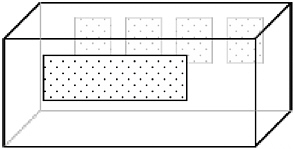
Surface area of each opening is at least 16% of wall surface area.
Each opening must be above midline of enclosure.
Option B: Four ventilation openings
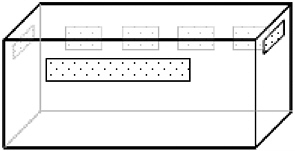
Surface area of each opening is at least 8% of surface area of that wall.
Each opening must be above midline of enclosure.
-
If the enclosure is permanently affixed to the conveyance so that there is only a front ventilation opening, this opening cannot be blocked, must open directly to an unobstructed aisle, must be at least 90% of the total surface area of the front wall, and must be covered with bars, wire mesh, or smooth expanded metal having air spaces.
Compatibility
-
Only one animal may be transported in a primary enclosure, except for
-
A mother and her nursing infant.
-
An established male-female pair or family group (but a female in estrus cannot be transported with a male nonhuman primate).
-
A compatible pair of juveniles of the same species that have not reached puberty.
-
-
Nonhuman primates of different species cannot be transported in adjacent or connecting enclosures.
Food and Water
-
Each animal 1 year old or older must be offered food at least once every 24 hr and water at least once every 12 hr.
-
Animals less than 1 year old must be offered food and water at least once every 12 hr.
-
Those periods start when an animal was last offered food and water before transportation began.
-
Each animal must be offered food and water within 4 hr before being transported or within 4 hr before delivery to a carrier or intermediate handler.
Documentation
-
Certifications must be securely attached to the outside of the primary enclosure in a manner that makes them easily noticed and read.
-
For surface transportation only, documents may be held by the operator of the conveyance. Certification must include
-
Consignor’s name, address, and dated signature.
-
Consignee’s name, address, and telephone number.
-
Species of nonhuman primate.
-
Time and date when animal was last fed and watered (not to occur more than 4 hr before delivery to carrier or intermediate handler).
-
Instructions for in-transit food and water requirements for a 24-hr period, administration of drugs or medication, or other special care required.
-
-
Certification of acclimation (required only if the temperature of the animal holding area is less than 45°F) must include
-
Consignor’s name and address.
-
Species of nonhuman primate.
-
Signed statement from veterinarian, dated no more than 10 days before delivery, that the animal is acclimated to temperatures lower than 50°F and the specific minimal temperature the animal is acclimated to.
-
Delivery to Carriers and Handlers
-
Carriers and handlers cannot accept an animal for transportation more than 4 hr before departure time. This can be extended by 2 hr by agreement of the carrier and consignor.
-
Carriers and handlers cannot accept an animal for transportation unless the enclosure meets the requirements described above, the enclosure is free of obvious defects, the appropriate written certifications listed above are attached to the enclosure, and the carriers’ holding areas meet the minimal temperature requirements described below under “Terminal Facilities” unless the animal is accompanied by a certificate of acclimation (see “Documentation” above).
Terminal Facilities
-
Shipments of animals cannot be comingled with inanimate cargo in animal holding areas of terminal facilities. Nonhuman primates must not be placed near any other animals, including other species of non-human primates, and must not be able to touch or see any other animals, including other species of nonhuman primates.
-
All holding areas must be cleaned and sanitized as often as necessary to prevent an accumulation of debris and to minimize disease hazards. An effective program must be implemented for the control of insects, ectoparasites, and birds and mammals considered pests.
-
Ventilation must be provided to minimize drafts, odors, and moisture condensation. Auxiliary ventilation must be used when the ambient temperature is 85°F or higher.
-
The temperature must not fall below 45°F or rise above 85°F for more than 4 consecutive hr. Temperature must be measured at a point not more than 3 ft away from the outside of the enclosure and halfway up the side of the enclosure.
-
The facility must provide shelter from sunlight, extreme heat, rain, and snow.
-
Upon arrival at a facility, the carrier or handler must attempt to notify the consignee immediately and once every 6 hr thereafter. The time, date, and method of attempted notification, actual notification of consignee, and name of the person who notified or attempted to notify the consignee must be written either on the carrier’s copy of the shipping document or on the copy that accompanies the primary enclosure. If a consignee cannot be notified with 24 hr of arrival, the handler must return the animal to the consignor. If the consignee is notified but does not accept delivery within 48 hr of arrival, the handler must return the animal to the consignor.
Handling
-
When an animal is moved to or from a facility or conveyance, it must be sheltered from sunlight, extreme heat, rain, and snow.
-
The animal cannot be exposed to a temperature above 85°F for more than 45 min.
-
Transporting devices must be covered when the temperature falls below 45°F; the animal cannot be exposed to temperatures below 45°F for more than 45 min unless it is accompanied by a certificate of acclimation; temperature is measured from a point not more than 3 ft from the outside of the enclosure and halfway up the side of the enclosure.
-
Handlers must avoid causing physical harm or distress to the animal.
-
The enclosure cannot be placed on an unattended conveyor belt or on an elevated conveyor belt or tossed, dropped, needlessly tilted, or stacked in a manner that results in its falling.
-
The enclosure must be handled in a manner consistent with written instructions attached to it.
Primary Conveyance
-
The cargo space of conveyances to transport animals must be designed, constructed, and maintained in a manner that protects the health and well-being of each animal and ensures its safety and comfort.
-
The cargo space must have a supply of air that is sufficient for normal breathing of all animals, and entry of engine exhaust must be prevented.
-
Enclosures must be positioned in the cargo space in a manner that provides protection from the elements, allows each animal enough air for normal breathing, and allows for the removal of the animals in the event of an emergency.
-
During surface transportation, temperatures inside cargo areas must be kept at between 45°F to 85°F at all times.
-
During air transportation, cargo areas must be maintained at a level that ensures the health and well-being of each animal at all times.
-
The cargo space must be kept clean, and animals may not be transported with any items that may be expected to cause harm to them.
-
Enclosures containing nonhuman primates must be placed far enough away from animals that are predators or natural enemies. Regardless of whether the other animals are in enclosures, the nonhuman primates should not be able to touch or see them.
Care in Transit
-
During surface transportation, the operator of the conveyance must observe the animals at least once every 4 hr to ensure sufficient air and acceptable ambient temperatures. If an animal is in obvious physical distress, the operator must obtain appropriate veterinary care at the closest available facility.
-
During air transportation, animals must be observed at least once every 4 hr unless the cargo area is not accessible during flight, in which case animals must be observed whenever they are loaded or unloaded to ensure sufficient air and acceptable ambient temperatures. If an animal is in obvious physical distress, veterinary care must be provided as soon as possible.
-
During transportation, animals shall not be removed from their enclosure unless it is to be placed in another enclosure or facility that conforms to the appropriate AWA regulations. Only persons who are experienced and authorized by the shipper, consignor, or consignee may remove a nonhuman primate from its enclosure during transportation, unless it is required for the health or well-being of the animal.
GUINEA PIGS AND HAMSTERS, RABBITS, AND OTHER ANIMALS (9 CFR 3.35-3.41, 9 CFR 3.60-3.65, 9 CFR 3.136-3.142)
Enclosure
-
The primary enclosure must be strong enough to contain the animals securely and comfortably and to withstand the normal rigors of transportation.
-
The enclosure must be large enough that each animal has enough space to turn around normally while standing and to stand and lie in a natural position. Some species may be restricted in their movements when freedom of movement would constitute a danger to the animals or people.
-
Enclosure interiors must have no protrusions that could injure the animals.
-
For guinea pigs and hamsters, inner surfaces of fiberboard, cardboard, or plastic enclosures must be covered or laminated with wire mesh or screen where necessary to prevent escape.
-
Openings of the enclosures must be easily accessible at all times for emergency removal of animals.
-
Unless the enclosure is permanently affixed to the conveyance, adequate handles or handholds must be provided so that the enclosure can be lifted without tilting and to ensure that anyone handling it will not come into physical contact with animals in it.
-
Projecting rims must be on the exterior of walls that contain ventilation openings and provide a minimal air circulation space of 0.75 in.
-
Unless the enclosure is permanently affixed to the conveyance, it must be marked on top and on at least one side with the words “Live Animals” or “Wild Animals” in letters at least 1 in high and with arrows indicating the correct upright position of the enclosure.
-
A solid, leakproof bottom that prevents seepage of waste products outside the enclosure is required. Unless it is on a wire or other nonsolid floor, the enclosure must contain enough unused, nontoxic litter to absorb and cover excreta.
-
The primary enclosure must be cleaned and sanitized before each use.
-
The interior height and space per animal of each enclosure must comply with the following minimal standards for guinea pigs and hamsters (there are no minimal requirements for rabbits and other animals):
Guinea Pigs
|
Weight |
Minimal Interior Height of Enclosure |
|
<500 g |
15.2 cm |
|
>500 g |
17.8 cm |
|
Weight |
Minimal Enclosure Space per Animal |
|
<350 g |
193.6 cm2 |
|
350 to 600 g |
290.3 cm2 |
|
>600 g |
354.8 cm2 |
Hamsters
|
Minimal Interior Height of Enclosure |
||
|
Dwarf Hamsters |
12.7 cm |
|
|
All Other Hamsters |
15.2 cm |
|
|
Minimal Enclosure Space per Animal |
||
|
Age |
Dwarf Hamsters |
All Other Hamsters |
|
Weaning-5 weeks |
32.2 cm2 |
45.2 cm2 |
|
5 to 10 weeks |
48.3 cm2 |
71.0 cm2 |
|
>10 weeks |
58.1 cm2 |
96.8 cm2 |
-
The size and arrangement of ventilations openings must comply with one of the following options:
Option A: Two ventilation openings
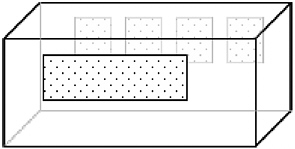
Surface area of each opening is at least 16% of surface area of that wall.
One-third of surface area of openings must be in lower half of enclosure, and at least one-third of surface area of openings must be on upper half of enclosure.
Option B: Four ventilation openings
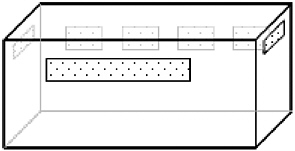
Surface area of each opening is at least 8% of surface area of that wall.
One-third of surface area of openings must be in lower half of enclosure, and at least one-third of surface area of openings must be on upper half of enclosure.
-
If the enclosure is permanently affixed to the conveyance so that there is only a front ventilation opening, this opening cannot be blocked, must open directly to an unobstructed aisle, must be at least 90% of the total surface area of the front wall, and must be covered with bars, wire mesh, or smooth expanded metal.
Compatibility
-
Animals transported in the same enclosure must be of the same species and be maintained in compatible groups.
-
No more than 15 rabbits, 15 guinea pigs, or 50 hamsters can be transported in the same enclosure. For all other animals, animals that have not reached puberty shall not be transported in the same enclosure with adult animals other than their dams; socially dependent animals (such as sibling, dam, and other members of a family group) must be allowed visual and olfactory contact. A female animal in estrus shall not be transported in the same enclosure with a male animal.
Food and Water
-
For guinea pigs, hamsters, and rabbits when transported for a period of more than 6 hr, food and water or a type of food that satisfies the requirement for food and water must be provided in the primary enclosure.
-
For all other animals, water must be offered within 4 hr before transportation and at least once every 12 hr after initiation of transporta-
-
tion. Consigned animals must be provided with water at least once every 12 hr after acceptance for transportation. Exceptions are allowed for animals that require water more frequently, are hibernating, or are under veterinary treatment.
-
Each animal must be fed at least once every 24 hr; exceptions are allowed for animals that require food more frequently, are hibernating, or are under veterinary treatment.
Documentation
-
Certifications must be securely attached to the outside of the primary enclosure in a manner that makes them easily noticed and read.
-
For surface transport only, documents may be held by the operator of the conveyance. Certification must include
-
Consignor’s name, address, and dated signature.
-
Number of animals in enclosure.
-
A statement that enclosure complies with US Department of Agriculture standards.
-
24 hr feeding instructions for animals other than guinea pigs, hamsters, and rabbits (whose enclosures should already contain sufficient food and water for the duration of transportation).
-
-
Certification of acclimation (required only if the temperatures of the animal holding area is less than 45°F) must include (it is important to note that the AWA does not recognize that guinea pigs can be acclimated to temperatures below than 45°F):
-
Consignor’s name and address.
-
Number of animals in shipment.
-
Signed statement from veterinarian, dated no more than 10 days before delivery, that the rabbit or hamster is acclimated to temperatures lower than 45°F and the specific minimal temperature the animal is acclimated to.
-
Delivery to Carrier and Handlers
-
Carriers and handlers cannot accept an animal for transportation more than 4 hr before departure time. This can be extended by 2 hr by agreement of the carrier and consignor.
-
Carriers and handlers cannot accept an animal for transportation unless the enclosure meets the requirements described above or the consignor furnishes the carrier with a certificate stating that the enclosure complies with the standards set forth in the AWA, the enclosure is free from obvious defects, the appropriate written certifications listed above are attached to the enclosure, and the carriers’ holding
-
areas meet the minimal temperature requirements described below under “Terminal Facilities” unless the animal is accompanied by a certificate of acclimation (see “Documentation” above).
Terminal Facilities
-
Shipments of animals cannot be commingled with inanimate cargo in animal holding areas of terminal facilities.
-
All holding areas must be cleaned and sanitized as often as necessary to prevent an accumulation of debris and to minimize disease hazards. An effective program must be implemented for the control of insects, ectoparasites, and birds and mammals considered pests.
-
Ventilation must be provided to minimize drafts, odors, and moisture condensation. Auxiliary ventilation must be used when the ambient temperature is 75°F or higher.
-
The temperature must not fall below 45°F or rise above 85°F ever or for more than 4 consecutive hr. Temperature must be measured at a point not more than 3 ft away from the outside of the enclosure and halfway up the side of the enclosure.
-
On arrival at a facility, the carrier or handler must attempt to notify the consignee at least once every 6 hr following arrival. The time, date, and method of each attempt at notification, final notification, and name of the person notifying the consignee shall be recorded on the copy of the shipping document retained by the carrier or intermediate handler and the copy accompanying the animal shipment.
Handling
-
When an animal is moved to or from a facility or conveyance, it must be sheltered from sunlight, extreme heat, rain, and snow.
-
The animal cannot be exposed to a temperature above 85°F for more than 45 min.
-
Transporting devices must be covered when the temperature falls below 50°F; the animal cannot be exposed to temperatures below 45°F for more than 45 min. Temperature must be measured from a point not more than 3 ft from the outside of the enclosure and halfway up the side of the enclosure.
-
Handlers must avoid causing physical harm or distress to the animals.
-
The enclosure cannot be tossed, dropped, needlessly tilted, or stacked in a manner that results in its falling.
Primary Conveyance
-
The cargo space of conveyances for transport of animals must be designed, constructed, and maintained in a manner that protects the health and well-being of each animal and ensures its safety and comfort.
-
The cargo space must have supply of air that is sufficient for normal breathing of all animals, and entry of engine exhaust must be prevented.
-
Enclosures must be positioned in the cargo space in a manner that provides protection from the elements, allows each animal enough air for normal breathing, and allows for the removal of animals in the event of an emergency.
-
During transport, auxiliary ventilation must be used in the cargo space when the temperature reaches 75°F. The temperature may not exceed 85°F or fall below 45°F except when rabbits are being transported and a certificate of acclimation to lower temperatures has been provided.
-
The cargo space must be kept clean, and animals may not be transported with any items that may be expected to cause harm to them.
Care in Transit
-
During surface transportation, animals must be observed at least once every 4 hr to ensure sufficient air and acceptable ambient temperatures. If an animal is in obvious physical distress, the operator must obtain appropriate veterinary care as soon as possible.
-
During air transportation, animals must be observed at least once every 4 hr unless the cargo area is not accessible during flight, in which case animals must be observed whenever they are loaded and unloaded to ensure sufficient air and acceptable ambient temperatures. If an animal is in obvious physical distress, veterinary care must be provided as soon as possible.
-
During transportation, animals shall not be removed from their enclosure unless it is to be placed in another enclosure or facility that conforms to the applicable AWA regulations.




















